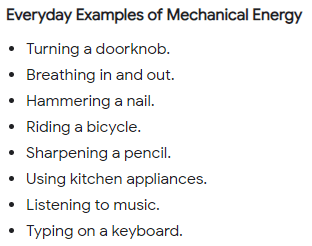Examples of Mechanical Energy
 Mechanical energy is the energy that a body or system derives from the speed of its movement or from its specific position and that is capable of producing mechanical work. Some Common examples of mechanical energy are potential energy and kinetic energy.
Mechanical energy is the energy that a body or system derives from the speed of its movement or from its specific position and that is capable of producing mechanical work. Some Common examples of mechanical energy are potential energy and kinetic energy.
It is produced by mechanical forces, such as elasticity, gravitation, etc., and bodies have it moving or displaced from its equilibrium position.
In general, mechanical energy involves both the kinetic energy, the elastic energy, and the potential energy of an object.
Mechanical energy is often used to do specific work or to convert it to other forms of energy, such as hydraulic energy, which harnesses the potential energy of falling water; wind energy, which uses the kinetic energy of the wind, or tidal energy, which uses the kinetic energy of the tides.
This does not occur in systems charged with movement (since mechanical energy is transformed into electromagnetic particles), in thermodynamic systems that undergo changes of state (transforming into thermal energy) or in dissipation mechanisms of continuous media (in which the energy is dissipated due to deformations and heat generation).
Mechanical Power Formula
Mechanical energy is conserved in conservative fields and in those that form purely mechanical action particles, remaining constant over time, according to the following formulation:
Emec = Ec + Ep + Ee
Where;
Ec: is the kinetic energy of the system
Ep: its gravitational potential energy
Ee: its elastic potential energy.
Types of mechanical energy
There are two types of mechanical energy:
Kinetic energy
That which is derived from the movement of objects or systems and that has to do with their speed and displacement. For example, a moving ball.
Energy potential
That which has to do with the position or shape of objects or systems, on which a work capacity depends and which, in turn, can be of two types:
-
Gravitational potential energy
That is due to the action of gravity on the bodies, as is the case of an object that falls from a height.
-
Elastic potential energy
It has to do with the constitution and shape of the object’s material, which tends to regain its original shape after being subjected to forces that deform it, such as a metal spring.
Examples of mechanical energy
Mechanical energy according to its different forms can be exemplified as follows:
A pendulum:
The classic example of how the potential gravitational energy of weight is converted to kinetic energy to make it move on its way, preserving total mechanical energy.
A roller coaster cart:
At its highest point of ascent, the car will have accumulated enough gravitational potential energy (due to height) to fall free a second later and convert everything to kinetic energy (due to movement), and reach breakneck speeds.
A springboard:
The swimmer who jumps on a trampoline uses his weight (gravitational potential) to deform the trampoline downwards (elastic potential) and the latter to regain its shape, pushes it upwards to increase its height (gravitational potential) which is converted into kinetic energy during free fall in the water.
A windmill:
The kinetic energy of the wind gives an impulse that the blades of the mill endure and become mechanical work: turning the gear that will crush, underneath, the grain or wheat of the farmer.
Forms of mechanical energy
Energy can manifest itself in different ways: in the form of movement (kinetics), position (potential), heat, electricity, electromagnetic radiation, etc … Depending on the process, it is called energy:
- Thermal energy
- Electricity
- Radiant energy
- Chemical energy
- Nuclear energy
Related Topics:
- Mechanical Energy
- Kinetic energy
- Potential Energy
- Geothermal Energy
- Sources of energy
- Nuclear energy
- Conservation of Energy
- Solar Energy
- Radiant Energy
